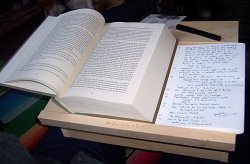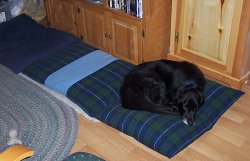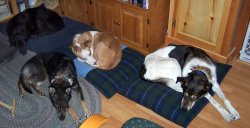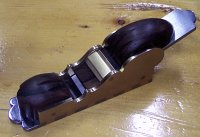
desk on my lap
When I started reading Mason & Dixon several years ago I spent the first half looking up all the obscure references, keeping track of all the characters; trying to figure out exactly what Pynchon was saying in the book. Eventually I got tired of this approach and just wanted to finished the damned thing. So I abandoned all my research and read it as I would read Nick Hornby or any of the other books you buy at the airport to get through your flight. But since I never really "got" the second half of the book, I want to re-read it again and catch up on all the things I missed.
Since that book, which I finished in 2000, I've read a lot of books with historical context, most recently William T. Vollmann's Europe Central. The Internets (tubes, not trucks, don't 'cha know), especially the Wikipedia, really bring a lot to reading books like this if you have the dedication to look up the historical references and learn the context surrounding the story the author is telling. For example, the Warsaw Riots were mentioned by one of the characters in Europe Central, so I read a little of the history. I also read Antony Beevor's Stalingrad to fill in those gaps in my knowledge. And the Warsaw Riot section of the Wikipedia linked the movie The Pianist (which I'd watched on DVD several years ago) to what I'd been reading. Dmitri Shostakovich is one of the characters in the book, so I downloaded his Seventh Symphony (part of which was written during the siege of Leningrad) and several Shostakovich pieces mentioned in the book. All of these connections were made because I took the time to look away from the pages of the book and fill in the details on my own. And now I have a much fuller understanding of what World War II was like and what the consequences were on the people who lived through it (or didn't, I suppose).
I'm currently reading Against the Day. Having a comfortable place to read the book, keep track of all the details, and be able to look stuff up will make getting through my twenty pages a day a lot easier. We've only got one comfortable place to sit in the house, so I'm reading the book on the couch, listening to music on the stereo. My laptop is next to me on the end table with the Wikipedia, an online dictionary and the Pynchon wiki open in Firefox.
To make it easier to take notes and read a book that weighs as much as a brick, I'm going to build a lap desk. Jefferson used one of his own design so he could write wherever he went, and wrote the majority of the Declaration on it. I've styled mine (with help from a fellow Galoot on the OldTools List) more along the lines of a Shaker lap desk. The photo shows the prototype I built from scrap pine. When I get around to building the real version I'll use some walnut that's been sitting in the garage for six or seven years waiting for the right project.
I also thought about what sort of notebook to use while reading. I could make a blank book, but I don't know how many pages I'll really need, so I'll make the notebook a section at a time, and after I've finished the book, bind the sections together. I used six sheets of paper, folded in half, and then sewn once through with linen thread. When the time comes to bind them together, I'll remove the existing thread, punch new holes and bind it. Because the sections are almost completely loose, they're easy to handle on the desk and lay flat for easy writing. I'm currently 60 pages into the book and have filled five pages. If I keep up that pace, I'll have a 90 page notebook when I'm finished (four sections). If you're thinking about doing this for your reading, keep in mind that you can't use normal paper for this because the grain of regular paper is going the wrong direction (up and down, or long-grain). You need short-grain paper in order to fold it in half and get pages that lay properly and won't curl.
Broken Social Scene and Swan Lake are cued up on iTunes, so it's time to get to my twenty pages. Last time I learned about the Haymarket Riot and Maxwell's Equations. I wonder what I'll learn today?

Yesterday when I was walking Piper and Nika on campus the tips of my ears got cold. I have a wool cap I wear when it's really cold, but I had my Pendleton hat on instead. It seems like whenever I'm wearing it, someone comments on it, and it does keep my head warm. But what to do about my ears?
A couple winters ago we bought some wool yarn, circular needles, and a few knitting books with the intention of knitting stuff; a hat to start because it seemed easier than socks and quicker than something like a sweater. Browsing around the knitting store, looking at all the cool yarn, and thinking about actually making something to wear from scratch got me all excited about the project.
Most of the time this sort of enthusiasm carries me through the first three-quarters of a project, and the desire to finally get the damned thing done gets me through the rest. This time, though, I started out overly ambitious, and my interest petered out after nine or ten rows.

Today I pulled it off the shelf in the living room and got back to work. I figure about ten more rows and I'll have a very simple knit ring I can pull over my ears, but below my stylin' hat, to keep my ears warm. And better than that, maybe the satisfaction of finishing my first knitting project will tempt me into starting and finishing a real project, like the hat I'd been thinking of a couple years ago.
There's a fire burning in the wood stove, Spoon's Kill the Moonlight on the stereo, and I'm ready to roll.
Update, Wed, 08 Nov 2006: I finished it this evening, and you can see what it looks like under my hat on the image to the left. It fits just about perfectly, but it's not really all that stretchy. I think that's because the last half of it was done entirely with knit stitches. I started with some sort of knit / purl ribbing, but one of the reasons I put the project down for two years was that it was too much for me to handle at the same time I was learning to knit.
Today when I went out to take care of the neighbor's cats I noticed that I'd worn through the leather soles of my cowboy boots. I went upstairs and got my older pair and while I was slipping them on I remembered buying them in California as a pair of boots to go with my new motorcycle. That was in 1991, so those boots are more than 15 years old.
More and more I find myself coming across something that I've owned for more than a decade, or a memory occurs to me from longer ago than seems possible. I'm no longer in my 20's, and even though I know this, it still feels like I'm a young kid who has just graduated from college, just old enough to drink beer. Maybe not yet wise enough to know not to drink too many.
But I'm not that young kid anymore. I've been a lot of places and done a lot of things since then. A lot of it has been chronicled in my journals, or in the other pieces of paper and electronic records that are part of every person's life. I'm thinking it might be fun to make a journal book that would be a sort of lifetime accounting for the places I've been and the things I've done. My journal books are 192 pages, and if I put four months on a page, I can cram around 63 years into the book. With four months per page, that's around six lines per month, which sounds like just the right amount of space. I'll put the details of the book itself on my bookbinding pages.
June 1991: bought motorcycle and cowboy boots.
Check.

Everyone has old sheets and pillows laying around. If you're a dog owner and you've got a sewing machine, it's really easy to make an excellent dog bed. The flannel dog beds shown here are 27" x 35", hold two pillows, and all you need to buy is a zipper. The blue bed in the corner is a bit larger and was made by a friend of ours. She originally had it filled with cedar, but we put pillows inside.

With flannel sheets, the bottom sheet will wear out long before the top sheet does, so use the top sheet for the project. It's easiest to cut two large rectangles out of the sheet, adding at least an inch all the way around for the stitching. Sew the two sides of the zipper first, zip it up, turn it inside out, and sew the other three sides and the area on either side of the zipper. The only tricky part is the sewing near the zipper ends. You may want to consult an expert or check out your local used bookstore for a sewing book. Velcro is probably easier.

I'm one of the moderators (ListMom) of an OldTools email list. This year, a bunch of the galoots on the list got together and had planemaker Wayne Anderson build me and the other ListMom a chariot plane. The plane is absolutely gorgeous, with brass sides perfectly dovetailed into the steel bottom, and some sort of tropical hardwood that holds the iron perfectly. It's a bevel-up plane, and in my initial, ahem, testing, it handles the toughest grain I had to throw at it.

Click on the images for a larger view. In the side shot you can see Wayne's signature, as well as the microscopically tight mouth on the plane.
And if that wasn't enough, the left over money went into a Lee Valley gift certificate. I've already got a shoulder plane and a couple books on the way. Thanks to everyone on the list for their generosity.
It's a great list, with great folk. If you're at all interested in working wood by hand, or in collecting old hand tools, check it out.